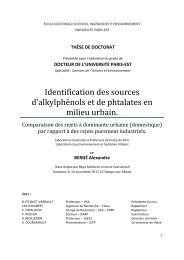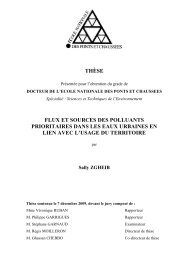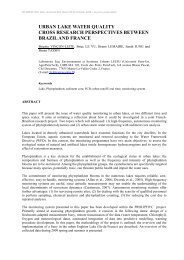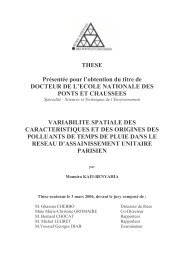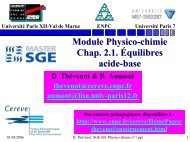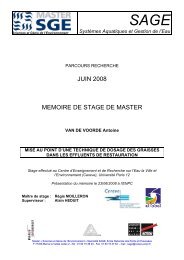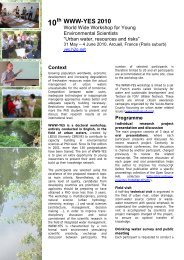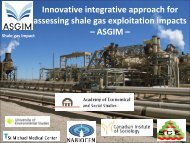View - ResearchGate
View - ResearchGate
View - ResearchGate
Create successful ePaper yourself
Turn your PDF publications into a flip-book with our unique Google optimized e-Paper software.
INTRODUCTION21 Monitoring of urban stormwater pollutants inboth particulate and dissolved phases inseparate sewersS. Zgheib*, R. Moilleron*, M. Saad* and G. Chebbo*,*** Cereve, UMR-MA102, Université Paris-Est, AgroParisTech, France(E-mail : sally.zgheib@cereve.enpc.fr , moilleron@univ-paris12.fr ,saad@cereve.enpc.fr)** Faculté de Génie, Université Libanaise, Lebanon(E-mail : chebbo@cereve.enpc.fr)Abstract Organic and minerals pollutants are nowadays part of urban environment.They are ubiquitous in every component: soil, air, water, sediments. During a rainevent, stormwater quality as well as the contaminant loads are affected by atmosphericdeposition and the types of impervious urban surfaces, on which runoff occurs. Studieshave shown that the variety of contaminants is related to the land use of each urbanwatershed. As a consequence, three sites in Paris and its suburb, whose watershed landuse differs, were investigated. A screening of 88 stormwater pollutants will be carriedout on samples collected at the outlet of these sites on both the dissolved and theparticulate phases. In this paper, we will present a description of these three sites andof the monitoring strategy. As a consequence, this study will provide an original set ofdata for a large number of stormwater pollutants, both in the dissolved (μg.l-1) and theparticulate (μg.g-1) phases for urban areas with different land use pattern.Keywords Priority pollutants; runoff; screening; urban watershed; water framedirectiveLand development increases stormwater runoff volumes and pollutants concentrations.Impervious surfaces, such as rooftops, driveways and roads, prevent infiltration of rainfall andrunoff into the ground and degrade the runoff quality. Urban runoff volume can be affected bydifferent factors: the quantity of rain and the extent of impervious surfaces connected to astream or drainage system. However, urban areas can be equipped with three types of sewers:sanitary or separate sewers, storm sewers and combined sewers. Each of these types hasspecific properties related to sewer processes. In case of separate storm sewer, the residencetime of stormwater is quite short, and in general it ends up in watercourses without treatment.Stormwater quality becomes a crucial issue and an improved knowledge of its contamination isrequired.Besides, the European Water Framework Directive (WFD) n° 2000/60/EC (EC 2000a)requires, a progressive reduction of discharges of priority substances into water bodies and thecessation of discharges of priority hazardous substances. The European Parliament decision n°2455/2001/EC (EC 2001) highlighted on a list of 33 priority substances that must be reducedby 2015 or eliminated by 2020. Industrial and agricultural effluents as well as urban water(wastewater and stormwater, water from separate and combined sewer systems, etc) areconcerned and should be analysed and quantified in order to define priorities for actions ofurban water management approach. But the main limitation of this list is, the choice of thesesubstances was relevant with respect to their specific industrial sources since they wereidentified using the COMMPS approach (Combined Monitoring-based and Modelling-basedPriority Setting). Thus, this list need to be expanded in order to include those carried fromurban areas.This paper focuses on stormwater pollution. One of the interesting features of our work is toextend the list of the 33 priority pollutants in order to include those specific to urbanstormwater. An innovative screening methodology of this extended list will be done at theoutlet of three separated storm sewers. A fully description of the screening methodology,precautions from sampling to analyses and the land use of each watershed are detailed in thispaper.The main objective of this research is to propose an appropriate list of urban stormwaterpollutants which is able to be monitored on both the dissolved and the particulate phases. Thisscreening can lead to asses the kind of pollutant generated from three watersheds havingdifferent land use pattern. The results can be used by managers in order to optimise the bestmanagement water practices and to contribute to reach the WFD goals.This research is performed within the framework of the third phase of the OPUR (Observatoryof Urban Pollutants) research programme, which aimed at improving knowledge of the origin,the characteristics and the transfer of pollutants in urban watersheds during dry and wetweather.SELECTION OF URBAN PRIORITY POLLUTANTSAfter an international literature review on monitoring programs and sources of urbanpollutants, we have established a new list of 88 individual chemical substances including, also,the ordinary water quality parameters (to evaluate the general pollution). These substancesshould be monitored to prevent any future problems of pollution with respect to their urbansources. The choice of these substances was based on three different approaches: Sources ofpollutants in an urban area, literature review of pollutants lists and European Directives. Theseapproaches are detailed as follow:Sources of urban pollutantsA number of studies have linked specific pollutants in stormwater runoff with their sources(Allen Burton et al., 2001). For this reason, firstly we have investigated the sources; the usesand the production of some pollutants in urban areas. Then, we have looked to their toxicitydegree, their bioaccumulation and their persistent in the environment.Indeed, during precipitation, urban contaminants may be removed from air by either rain-in orwashout (Gill et al., 1983) and their load, can also be affected by the types of imperviousurban surfaces on which runoff occurs. As a consequence, a large number of constituents, bothorganic and inorganic, may be present in stormwater (Eriksson et al., 2002), runoff orwastewater (Allen Burton et al., 2001, Garnaud, 1999, Gromaire-Mertz et al., 1999) or even instormwater at the outlet of a watershed. The measured concentrations may vary from event toevent and from site to site (Gromaire-Mertz et al., 1999), underlying the unique site-specific.In this paper, we have considered four urban sources of pollutants that could be, generally,found on an urban watershed. These sources and the kind of pollutants load are as follow:- Atmospheric deposits: organic substances (such as HAPs, PCBs, pesticides & alkylphenols);volatiles substances (BTEX & COHV); flame retardants (PBDEs, PCBs, chloroalkanes).- Traffic: metals (Zn, Cu, Pb, Pt, Cd); alkylphenols; HAPs.- Gardens: pesticides and their additives (alkylphenols, organotins).- Buildings: metals; nonylphenols; PBDEs; phtalates.Literature lists of pollutantsWWW-YES 2008, Paris 13 – 16 May 2008 179WWW-YES 2008, Paris 13 – 16 May 2008 180



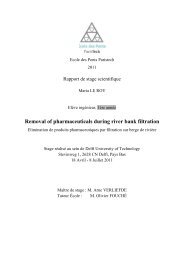
![[pastel-00730831, v1] Incidence des pratiques d'entretien ... - LEESU](https://img.yumpu.com/50938896/1/184x260/pastel-00730831-v1-incidence-des-pratiques-dentretien-leesu.jpg?quality=85)

